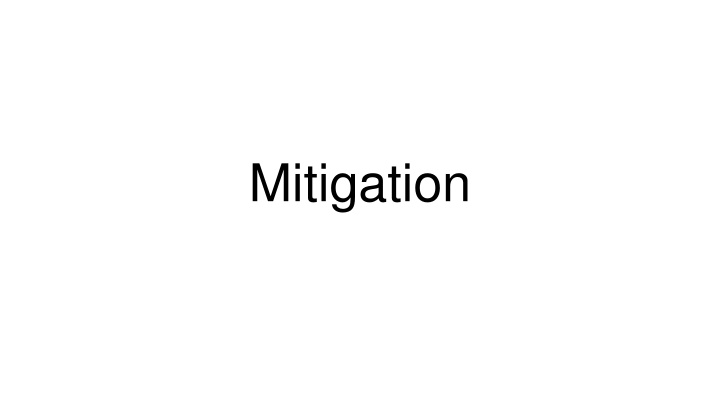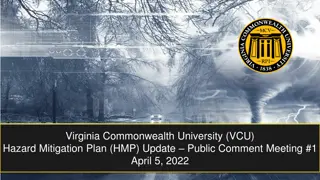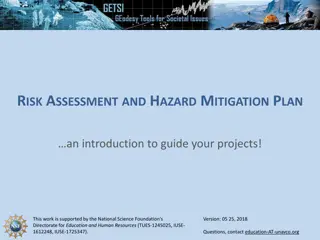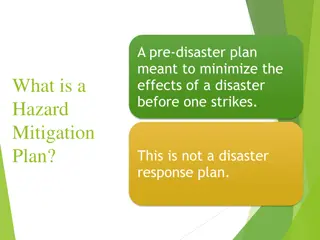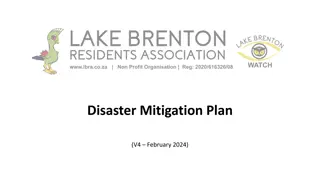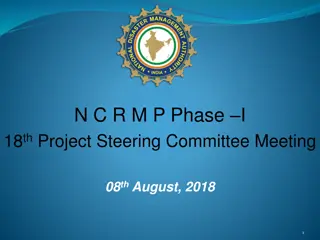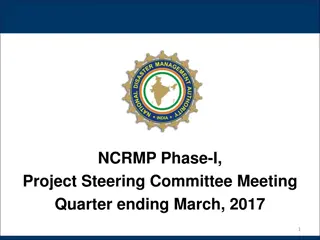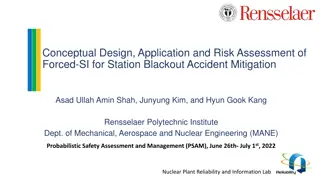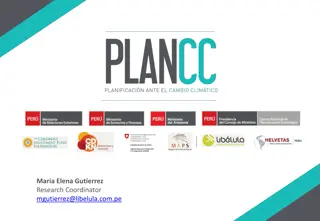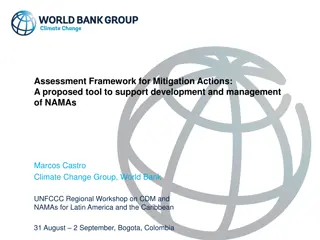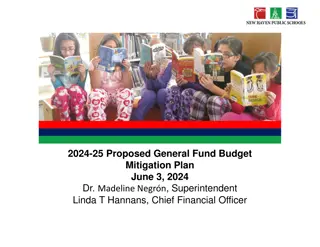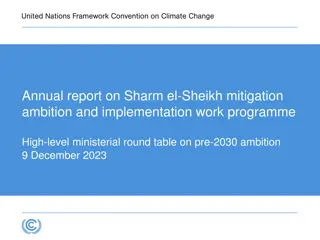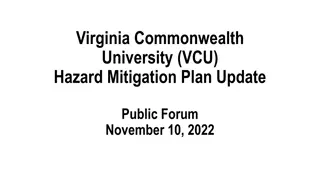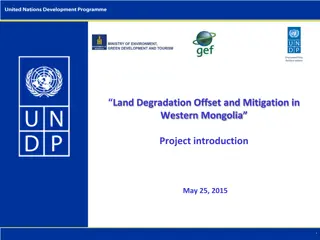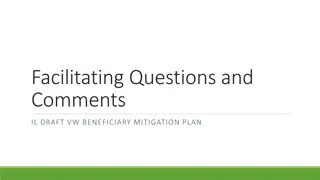Mitigation
Exploring the concept of mitigation with a focus on climate change, this content delves into the actions needed to reduce the severity of environmental issues. Learn how scientists tackled the ozone layer depletion and the cost/benefit analysis of mitigation strategies.
Download Presentation

Please find below an Image/Link to download the presentation.
The content on the website is provided AS IS for your information and personal use only. It may not be sold, licensed, or shared on other websites without obtaining consent from the author.If you encounter any issues during the download, it is possible that the publisher has removed the file from their server.
You are allowed to download the files provided on this website for personal or commercial use, subject to the condition that they are used lawfully. All files are the property of their respective owners.
The content on the website is provided AS IS for your information and personal use only. It may not be sold, licensed, or shared on other websites without obtaining consent from the author.
E N D
Presentation Transcript
What is mitigation? the action of reducing the severity, seriousness, or painfulness of something. What needs mitigating when it comes to climate? Think about things that need reducing The cause of climate change? The impacts of climate change?
How does mitigation happen? Watch this video and see what people did in order to mitigate the problem. Why you don t hear about the ozone layer anymore Finally, some good news about the environment. Subscribe and turn on notifications so you don't miss any videos: http://goo.gl/0bsAjO ? In the 80s, scientists discovered there was a hole in the ozone over the South Pole. A significant layer of gas that deflects much of the sun s radiation was disappearing much faster than anyone expected. Projections suggested it would collapse by 2050, increasing skin cancer rates, harming crops, and destroying the marine food chain. The situation was dire. But today, we are on the path to recovery. Dr. Susan Solomon, among other scientists, contributed key findings to understand what was depleting the ozone layer and how to address it. In this video she takes us back to her expedition to Antarctica, breaks down how we managed to fix this huge problem, and looks at our next big environmental challenge climate change with the unbridled optimism that drove her to fix the ozone hole. Further reading: To learn about the scientific discoveries by Mario J. Molina and F. Sherwood Rowland that kickstarted research into chlorofluorocarbons (CFCs) in the 70s, take a look at their groundbreaking paper here: https://www.nature.com/articles/249810a0 To read the 1985 paper that revealed there was an ozone hole forming over the South Pole, click here: https://www.nature.com/articles/315207a0 You can find Solomon s 1986 paper on her Antarctica expedition here: https://www.nature.com/articles/321755a0 To read more of Solomon s work, check out her publications here: https://eapsweb.mit.edu/people/solos To understand the Montreal Protocol in more detail, read the United Nations Environment Programme s summary here: https://www.unep.org/ozonaction/who-we-are/about-montreal-protocol Vox.com is a news website that helps you cut through the noise and understand what's really driving the events in the headlines. Check out http://www.vox.com Make sure you never miss behind the scenes content in the Vox Video newsletter, sign up here: http://vox.com/video-newsletter Support Vox's reporting with a one-time or recurring contribution: http://vox.com/contribute-now Shop the Vox merch store: http://vox.com/store Watch our full video catalog: http://goo.gl/IZONyE Follow Vox on Facebook: http://facebook.com/vox Follow Vox on Twitter: http://twitter.com/voxdotcom Follow Vox on TikTok: http://tiktok.com/@voxdotcom
Ozone Layer Discussion How did they mitigate the issue? Personal - what did individuals do to help the ozone layer problem? Public - what did the public do to help the ozone layer problem? How did they carry out the mitigation strategy? What did it cost? (Time/Money) What are the benefits of the mitigation strategy? What are the new negative of the mitigation strategy?
Cost/Benefit Analysis If large problems such as the ozone layer and climate change were so easy to fix, we probably would have done it by now. We have to consider the cost vs. the benefits of certain mitigation strategies. Who does it help and who does it harm? Let s look at electric cars as an example
Electric Cars Cost/Benefit Analysis Do some research with your group, what are the pros and cons of electric cars? Pros Cons No fossil fuels used as gasoline Less oil fields and oil having to be mined Runs on electricity Electricity can be from renewable sources such as wind, solar, and hydroelectric Once charged does not ACTIVELY produce CO2emissions TESLA factories are run 100% on solar Lithium batteries Lithium has to be mined and habitats can be destroyed doing that Runs off electricity from your home which in Indiana is 75% produced from fossil fuels (coal & natural gas) Uses a lot of metal to produce the body Fossil fuels are used to power the factory that it was produced in Electric cars are more expensive - WHY?
Lithium mining Oil mining Metal found in the earth and in salt water brine Major mining locations - Canada, Australia, Bolivia, Columbia Mining operations take up less space than oil operations 88 million tons of lithium estimated Batteries last up to 10/20 years Doesn t produce CO2 Can produce arsenic and pollute water sources Crude oil is extracted from the earth from wells, tar sands Major oil reserves in Middle East and Russia Take up a lot of space and produce CO2just by drilling and releasing the oil from the Earth Water pollution from burst pipes, oil spills, etc. Makes money because most things still run on oil
What do you think? Which is better? Electric Vehicles or Gasoline Vehicles?
Your Turn! One of the sectors will be assigned to your group. You will work with your group to do additional research and fill out your white board with the following template. Agriculture Land Use/Forestry Transportation Industry Electricity Commercial/Residential Use your Mitigation Notes to help you get started. Once the white boards are filled out, you will do a gallery walk and fill in your notes. Make sure to ask questions and to get explanations if you need them. These notes are for you and it's important you understand how complex mitigation strategies can be
From what you learned about mitigation, what is stopping us from fixing climate change?
Climate Change is NOT your fault, but you can help stop it Climate Change Isn't Your Fault, But You Can Help Stop It | David Yeomans | TEDxTexasStateUniversity You ve been told that you are causing climate change by driving your dirty car, taking a flight to go on vacation, or eating red meat; but the real concern is who we are not talking about. After seeing the statistics, you may be surprised where we should point the finger and how little you have to change your life to stop global warming. David Yeomans is a Three-time Emmy Award-winning Meteorologist. David has been fascinated with weather for as long as he can remember. David was a published undergraduate researcher under world-renowned climate change expert, Dr. Brian Soden, studying the relationship between water vapor in the high levels of the atmosphere and global warming. David researched hurricane formation for his Master s thesis and was a guest scientist aboard an NOAA Hurricane Hunter flight. He is now a Chief Meteorologist at KXAN Austin. This talk was given at a TEDx event using the TED conference format but independently organized by a local community. Learn more at https://www.ted.com/tedx
